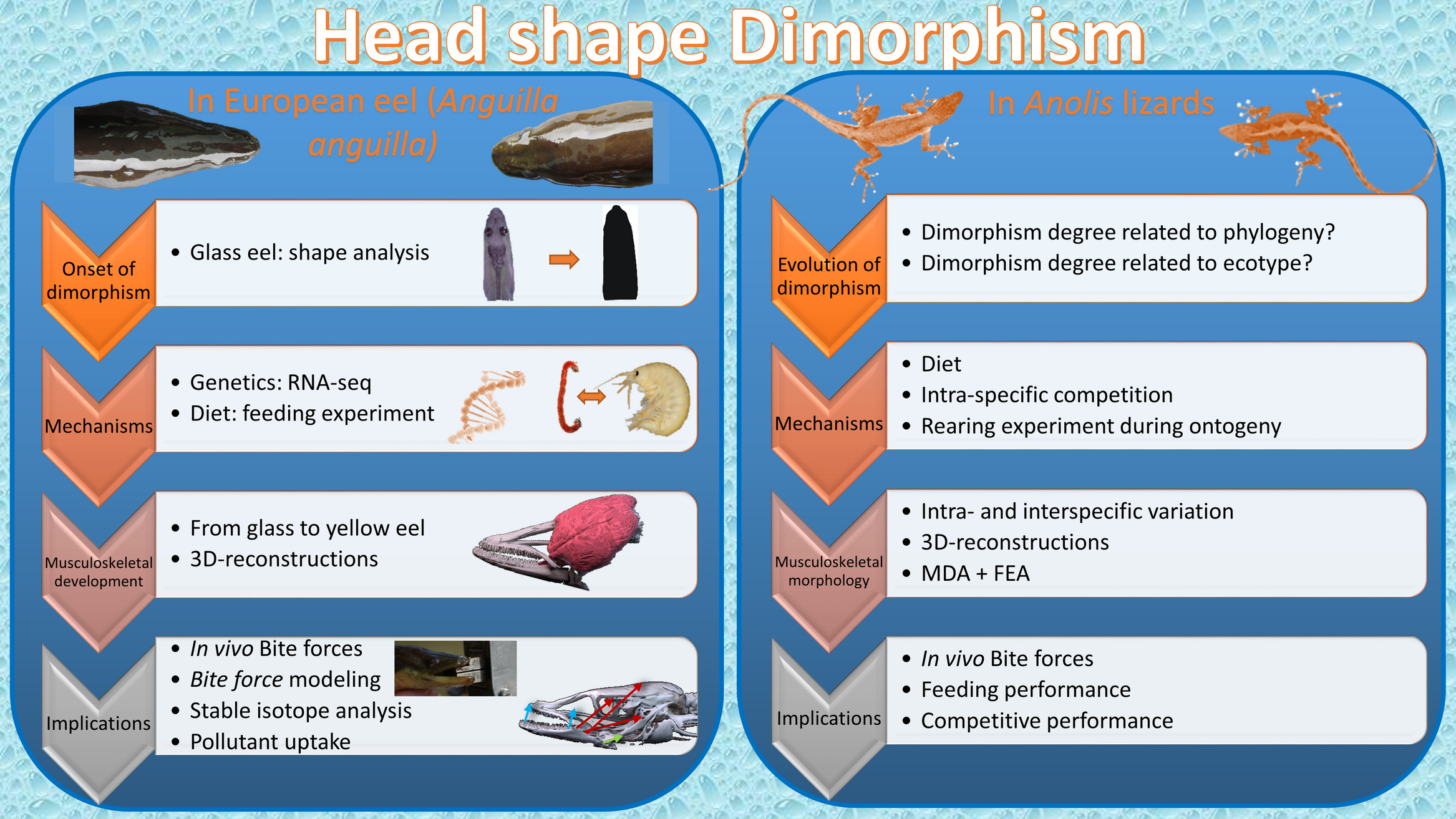Head shape dimorphism in vertebrates
Project focus
General introduction
The presence of two phenotypes within a single species, a phenomenon known as dimorphism, is common among several species. Dimorphism in head shape is an exceptionally interesting type of dimorphism, since head shape plays a role in several important performance-related behaviors. Due to its direct influence on bite force, head shape is related to diet, inter- and intra-specific competition for territory and competition for mates. At the same time, head shape can affect other factors, such as burrowing efficiency, hiding into crevices or as a warning signal towards other individuals. This makes head shape dimorphism an ideal phenomenon to study the link between ecology, morphology and performance.
Project 1: Head shape dimorphism in European eel
Among eel biologists and fishermen, it is known that two phenotypes occur in the European eel yellow eel stage: broad- and narrow-heads. Although this phenomenon was already described in 1922 by Törlitz, little is known about the occurrence of these two phenotypes. In this project, we wanted to enhance our understanding of the head shape dimorphism in European eel. The European eel exhibits a complex life cycle. It spawns in the Sargasso Sea, from where leptocephalus larvae are transported towards the coasts of Europe. Arriving there, the larvae undergo a metamorphosis to glass eel. These eels start migrating up the rivers and lakes, meanwhile becoming more and more pigmented, going from the glass stage, over the elver eel stage to yellow eel. The latter stays in European waters until it has accumulated enough fat to return to the Sargasso Sea, as a maturing silver eel, to spawn and die. Since the head shape dimorphism is observed in the yellow eel stage, we first wanted to find out when this phenomenon starts to occur. For this, we performed a head shape analysis on glass eels and tested which modality type was followed. Second, we wanted to test what mechanisms are driving the head shape variation. For this, we compared gene expression patterns between broad- and narrow-headed glass eels using RNA-seq. In addition, we performed a feeding experiment, where eels were fed different diets (hard vs. soft) and the effect on shape was evaluated. Third, we wanted to find out how broad- and narrow-headed eels differed from each other in the different life stages (glass – elver – yellow eel stage). For this, 3D-reconstructions were made of the skulls and muscles of these eels and these were compared with each other. Finally, we wanted to find out how this dimorphism affects the life of the European eel. Using in vivo bite force measurements and bite force modeling, we compared the bite force between the two phenotypes, which could then be linked to diet. In addition, we evaluated whether differently shaped eels actually differ in trophic position using a stable isotope analysis. Finally, we tested whether these differences in trophic position lead to differences in pollutant accumulation. This is very important, since the European eel is considered critically endangered, with pollution being one of the drivers behind the eel decline.
*The results of these studies can be found under “publications”.
** Ongoing projects: 1) Differences in migratory patterns between differently shaped yellow eels
2) Head shape, diet and migration in glass eels
3) Changes in musculoskeletal morphology during silvering
Project 2: Head shape dimorphism in Anolis lizards
Anolis lizards are a highly diverse clade of lizards that has been intensively studied for their exceptional ecomorphological radiation, and that shows varying levels of sexual dimorphism. Males generally have larger bodies and heads than females, allowing them to bite harder (beneficial both for feeding and male-male competition). As such, they have served as a model clade to better understand the mechanisms behind evolutionary diversification and adaptation. Still, several mechanistic aspects remain unexplained, such as the ones driving head shape dimorphism. In this project, we want to tackle three aspects of head shape dimorphism in Anolis. First, we want to test whether the degree of dimorphism is related to phylogeny or to ecology. Second, we want to determine whether diet (prey size and hardness) and/or intraspecific competition affect head shape in Anolis lizards. For this, we will rear A. sagrei hatchlings until adulthood on different diets and/or on different degrees of competition. We will then evaluate how both bite force and head shape change during the lizards ontogeny and test the effect of the different treatments on head shape. Furthermore, we will test whether the different treatments have an effect on feeding efficiency or on competitive success. Subsequently, we will quantify in 3D the phenotypic responses to these manipulations in the cranial musculoskeletal system using 3D-reconstructions. In addition, we will test whether the skulls are adapted to deal more efficiently with harder and larger prey using multibody dynamics and finite element analysis (FEA). Finally, we want to compare the cranial musculoskeletal morphology between Anolis species, in order to analyze the diversity in internal morphology between species and to find patterns in how this is related to the external head shape and. With this approach, we hope to enhance our insights in the mechanisms driving the evolution of dimorphism in anoles.
Keywords
Evolution; Ecomorphology; Pollution; Performance
Researchers: Jens De Meyer (PI), Dominique Adriaens (co-PI), Anthony Herrel (co-PI)
